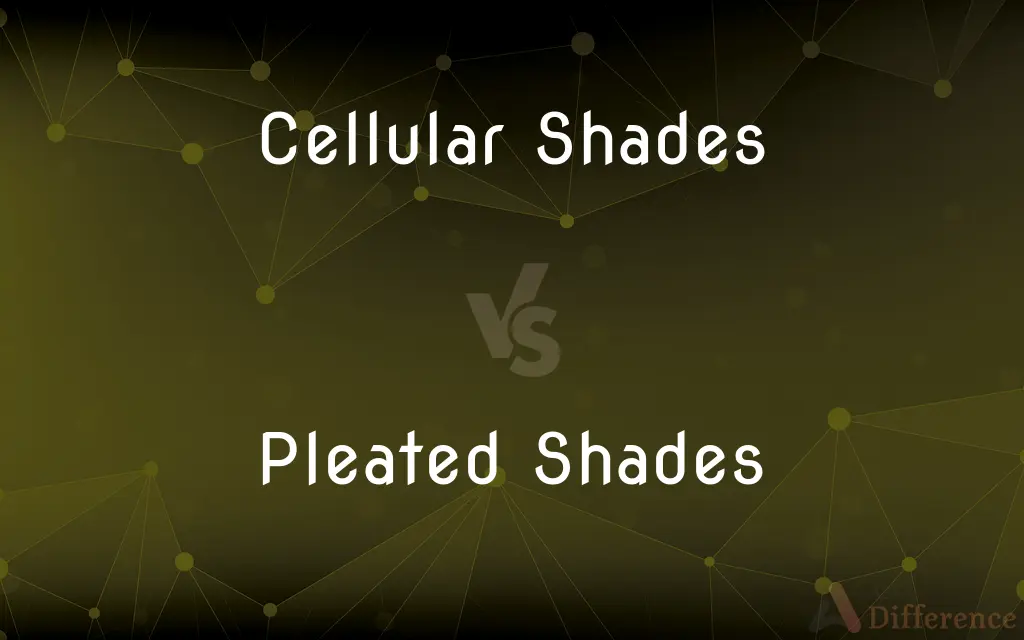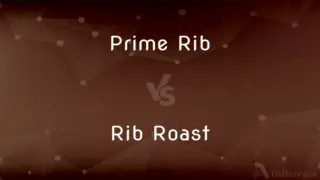Cellular Shades vs. Pleated Shades — What's the Difference?
By Urooj Arif & Maham Liaqat — Published on March 1, 2024
Cellular shades offer insulation with their honeycomb design, reducing energy costs. Pleated shades, while visually similar, lack the air-trapping cells, providing style over function.

Difference Between Cellular Shades and Pleated Shades
Table of Contents
ADVERTISEMENT
Key Differences
Cellular shades are distinguished by their unique honeycomb-shaped pockets, designed to trap air and provide insulation. This design helps to keep indoor temperatures more consistent, potentially lowering heating and cooling costs. Pleated shades, in contrast, have a single layer of fabric that is pleated. They offer a similar aesthetic but without the same level of insulation and energy efficiency.
Both cellular and pleated shades come in a variety of colors and textures, allowing for a high degree of customization to fit interior design needs. However, the functionality of cellular shades extends beyond aesthetics, contributing to their popularity among homeowners seeking energy-efficient window treatments. Pleated shades, while stylish, primarily serve as a light-filtering and privacy solution.
The installation process for both types of shades is relatively straightforward, making them accessible choices for DIY home improvement projects. However, cellular shades might require a slightly higher investment due to their complex structure and the benefits they provide. Pleated shades often appeal to those prioritizing cost and style flexibility.
Maintenance of both cellular and pleated shades involves regular dusting and occasional spot cleaning. Cellular shades, however, may need more careful cleaning to prevent damage to their delicate structure. Pleated shades offer easier maintenance due to their simpler construction but may also show wear more visibly over time due to the nature of their material.
When it comes to usability and functionality, cellular shades often feature options for top-down/bottom-up operations, allowing for adjustable privacy and light control. Pleated shades typically provide a more basic function, with fewer options for customization in light and privacy control but still offer an attractive solution for those seeking straightforward window coverings.
ADVERTISEMENT
Comparison Chart
Design
Honeycomb cells for insulation
Single layer of pleated fabric
Insulation
High; traps air to maintain temperature
Low; lacks air-trapping cells
Energy Efficiency
Reduces energy costs
Minimal impact on energy costs
Customization
Wide variety of colors and textures
Similar variety in aesthetics
Maintenance
Requires careful cleaning
Easier maintenance; visible wear
Compare with Definitions
Cellular Shades
Feature honeycomb design for insulation.
Cellular shades kept her room warm in winter without turning up the heat.
Pleated Shades
Provides basic light filtering and privacy.
Pleated shades in the dining room offered privacy without sacrificing natural light.
Cellular Shades
Offer energy cost savings.
Installing cellular shades helped reduce their monthly energy bills.
Pleated Shades
Primarily decorative, offering style flexibility.
They chose pleated shades for their wide range of colors to match the décor.
Cellular Shades
Require gentle cleaning to maintain structure.
He used a vacuum with a soft brush attachment to clean his cellular shades carefully.
Pleated Shades
Single layer of pleated fabric.
Pleated shades added a simple, elegant look to the living room.
Cellular Shades
Can be top-down/bottom-up for privacy.
The top-down/bottom-up cellular shades allowed light in while keeping the room private.
Pleated Shades
More affordable than cellular shades.
Opting for pleated shades was a budget-friendly window treatment solution.
Cellular Shades
Available in various opacities for light control.
She chose blackout cellular shades for the bedroom to block out light.
Pleated Shades
Easy to install and maintain.
She appreciated how easily she could clean and maintain the pleated shades.
Common Curiosities
How do cellular shades improve energy efficiency?
Their honeycomb design traps air, creating a barrier that maintains indoor temperature and reduces energy costs.
Are cellular shades more expensive than pleated shades?
Yes, generally due to their complex design and the additional benefits they offer, such as insulation and energy efficiency.
Can either shade type be motorized?
Yes, both cellular and pleated shades are available in motorized versions for ease of use and convenience.
What are pleated shades?
Window coverings made from a single layer of pleated fabric, offering a similar aesthetic to cellular shades but without insulation benefits.
Can pleated shades help with insulation?
While they provide some barrier against the window, their single-layer fabric is less effective at insulation compared to cellular shades.
What are cellular shades?
Window coverings with honeycomb-shaped cells that provide insulation by trapping air.
What is the best use case for pleated shades?
Ideal for those seeking a stylish, cost-effective window covering solution that offers light filtering and privacy.
Which shade type is better for privacy?
Both can provide privacy, but cellular shades offer more options for adjustable privacy with top-down/bottom-up features.
How do I clean cellular shades?
Carefully dust and spot clean without compressing their structure; some may be vacuumed with a soft brush attachment.
Are pleated shades easy to maintain?
Yes, they are relatively easy to maintain with regular dusting and occasional spot cleaning.
Do cellular shades come in different colors and textures?
Yes, they offer a wide variety of colors, textures, and opacities to fit various decor styles and needs.
Which type of shade is more durable?
Cellular shades may offer greater durability due to their construction, but both types can last many years with proper care.
Can pleated shades block out light completely?
While they can significantly reduce light entry, they may not completely block out light without a blackout layer.
Are cellular shades suitable for all climates?
Yes, their insulating properties make them suitable for both cold and warm climates by helping to maintain consistent indoor temperatures.
Can I install these shades myself?
Both shades are generally considered suitable for DIY installation, with many manufacturers providing clear instructions.
Share Your Discovery

Previous Comparison
Prime Rib vs. Rib Roast
Next Comparison
BFA vs. MFAAuthor Spotlight
Written by
Urooj ArifUrooj is a skilled content writer at Ask Difference, known for her exceptional ability to simplify complex topics into engaging and informative content. With a passion for research and a flair for clear, concise writing, she consistently delivers articles that resonate with our diverse audience.
Co-written by
Maham Liaqat















































